Strategic Planning Process, Techniques, and Analysis: Unit 7 Report
VerifiedAdded on 2022/03/10
|18
|4081
|15
Report
AI Summary
This report provides a comprehensive overview of strategic planning, essential for business development and success. It begins by outlining the strategic planning process, including definitions and examples of corporate vision, mission, objectives, core competencies, and competitive advantages. The report then delves into the role of strategy and the issues involved in strategic planning, discussing various planning techniques like the BCG matrix and SPACE matrix. The utility and application of the BCG matrix as a growth planning technique is detailed. Furthermore, the report explores organizational and environmental audits, utilizing SWOT analysis and Porter's Five Forces model. The application of these tools is illustrated through examples, such as the organizational audit of Mulberry, demonstrating practical application of strategic planning concepts. The report aims to equip readers with a solid understanding of strategic planning principles and their practical implementation in business.
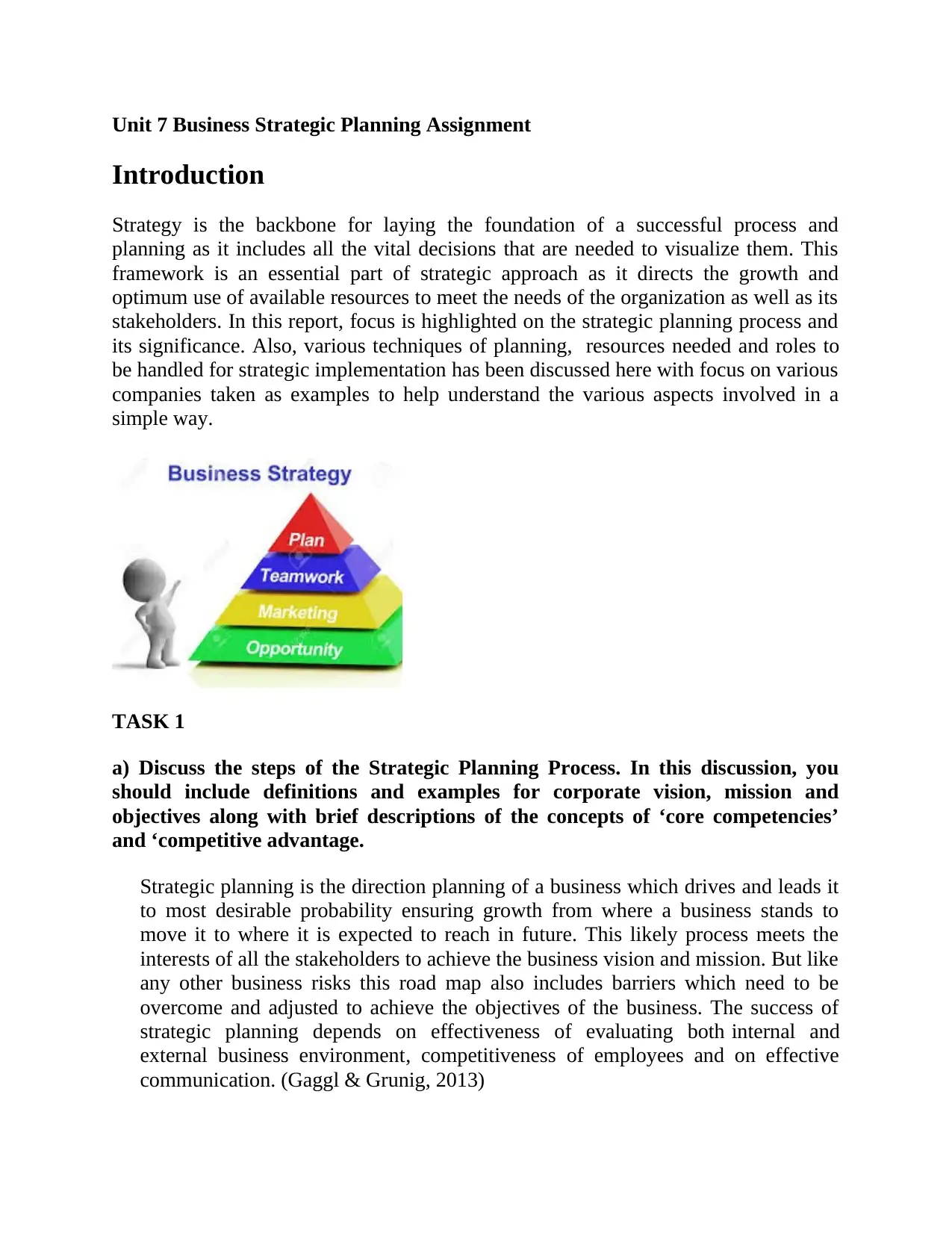
Unit 7 Business Strategic Planning Assignment
Introduction
Strategy is the backbone for laying the foundation of a successful process and
planning as it includes all the vital decisions that are needed to visualize them. This
framework is an essential part of strategic approach as it directs the growth and
optimum use of available resources to meet the needs of the organization as well as its
stakeholders. In this report, focus is highlighted on the strategic planning process and
its significance. Also, various techniques of planning, resources needed and roles to
be handled for strategic implementation has been discussed here with focus on various
companies taken as examples to help understand the various aspects involved in a
simple way.
TASK 1
a) Discuss the steps of the Strategic Planning Process. In this discussion, you
should include definitions and examples for corporate vision, mission and
objectives along with brief descriptions of the concepts of ‘core competencies’
and ‘competitive advantage.
Strategic planning is the direction planning of a business which drives and leads it
to most desirable probability ensuring growth from where a business stands to
move it to where it is expected to reach in future. This likely process meets the
interests of all the stakeholders to achieve the business vision and mission. But like
any other business risks this road map also includes barriers which need to be
overcome and adjusted to achieve the objectives of the business. The success of
strategic planning depends on effectiveness of evaluating both internal and
external business environment, competitiveness of employees and on effective
communication. (Gaggl & Grunig, 2013)
Introduction
Strategy is the backbone for laying the foundation of a successful process and
planning as it includes all the vital decisions that are needed to visualize them. This
framework is an essential part of strategic approach as it directs the growth and
optimum use of available resources to meet the needs of the organization as well as its
stakeholders. In this report, focus is highlighted on the strategic planning process and
its significance. Also, various techniques of planning, resources needed and roles to
be handled for strategic implementation has been discussed here with focus on various
companies taken as examples to help understand the various aspects involved in a
simple way.
TASK 1
a) Discuss the steps of the Strategic Planning Process. In this discussion, you
should include definitions and examples for corporate vision, mission and
objectives along with brief descriptions of the concepts of ‘core competencies’
and ‘competitive advantage.
Strategic planning is the direction planning of a business which drives and leads it
to most desirable probability ensuring growth from where a business stands to
move it to where it is expected to reach in future. This likely process meets the
interests of all the stakeholders to achieve the business vision and mission. But like
any other business risks this road map also includes barriers which need to be
overcome and adjusted to achieve the objectives of the business. The success of
strategic planning depends on effectiveness of evaluating both internal and
external business environment, competitiveness of employees and on effective
communication. (Gaggl & Grunig, 2013)
Paraphrase This Document
Need a fresh take? Get an instant paraphrase of this document with our AI Paraphraser
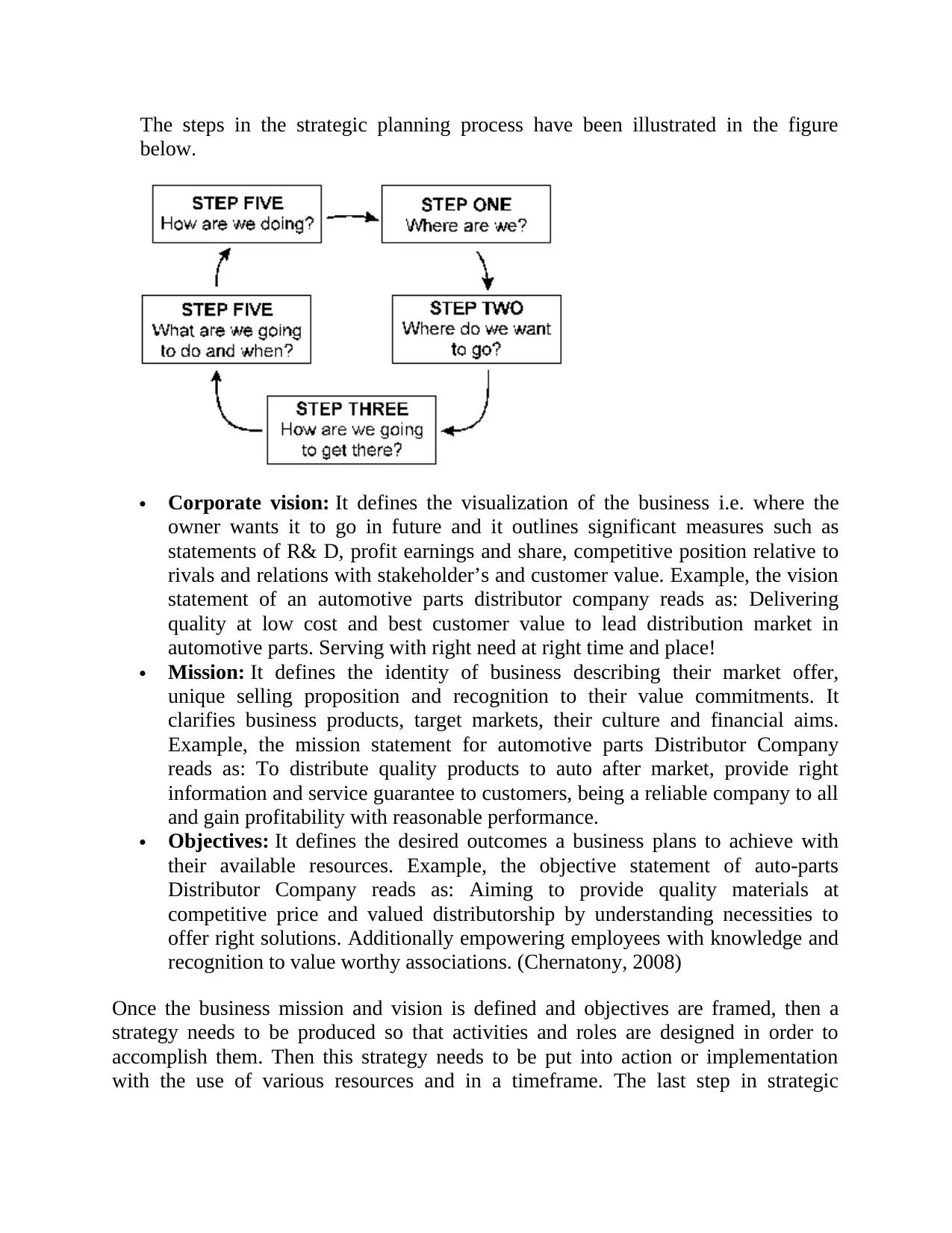
The steps in the strategic planning process have been illustrated in the figure
below.
Corporate vision: It defines the visualization of the business i.e. where the
owner wants it to go in future and it outlines significant measures such as
statements of R& D, profit earnings and share, competitive position relative to
rivals and relations with stakeholder’s and customer value. Example, the vision
statement of an automotive parts distributor company reads as: Delivering
quality at low cost and best customer value to lead distribution market in
automotive parts. Serving with right need at right time and place!
Mission: It defines the identity of business describing their market offer,
unique selling proposition and recognition to their value commitments. It
clarifies business products, target markets, their culture and financial aims.
Example, the mission statement for automotive parts Distributor Company
reads as: To distribute quality products to auto after market, provide right
information and service guarantee to customers, being a reliable company to all
and gain profitability with reasonable performance.
Objectives: It defines the desired outcomes a business plans to achieve with
their available resources. Example, the objective statement of auto-parts
Distributor Company reads as: Aiming to provide quality materials at
competitive price and valued distributorship by understanding necessities to
offer right solutions. Additionally empowering employees with knowledge and
recognition to value worthy associations. (Chernatony, 2008)
Once the business mission and vision is defined and objectives are framed, then a
strategy needs to be produced so that activities and roles are designed in order to
accomplish them. Then this strategy needs to be put into action or implementation
with the use of various resources and in a timeframe. The last step in strategic
below.
Corporate vision: It defines the visualization of the business i.e. where the
owner wants it to go in future and it outlines significant measures such as
statements of R& D, profit earnings and share, competitive position relative to
rivals and relations with stakeholder’s and customer value. Example, the vision
statement of an automotive parts distributor company reads as: Delivering
quality at low cost and best customer value to lead distribution market in
automotive parts. Serving with right need at right time and place!
Mission: It defines the identity of business describing their market offer,
unique selling proposition and recognition to their value commitments. It
clarifies business products, target markets, their culture and financial aims.
Example, the mission statement for automotive parts Distributor Company
reads as: To distribute quality products to auto after market, provide right
information and service guarantee to customers, being a reliable company to all
and gain profitability with reasonable performance.
Objectives: It defines the desired outcomes a business plans to achieve with
their available resources. Example, the objective statement of auto-parts
Distributor Company reads as: Aiming to provide quality materials at
competitive price and valued distributorship by understanding necessities to
offer right solutions. Additionally empowering employees with knowledge and
recognition to value worthy associations. (Chernatony, 2008)
Once the business mission and vision is defined and objectives are framed, then a
strategy needs to be produced so that activities and roles are designed in order to
accomplish them. Then this strategy needs to be put into action or implementation
with the use of various resources and in a timeframe. The last step in strategic
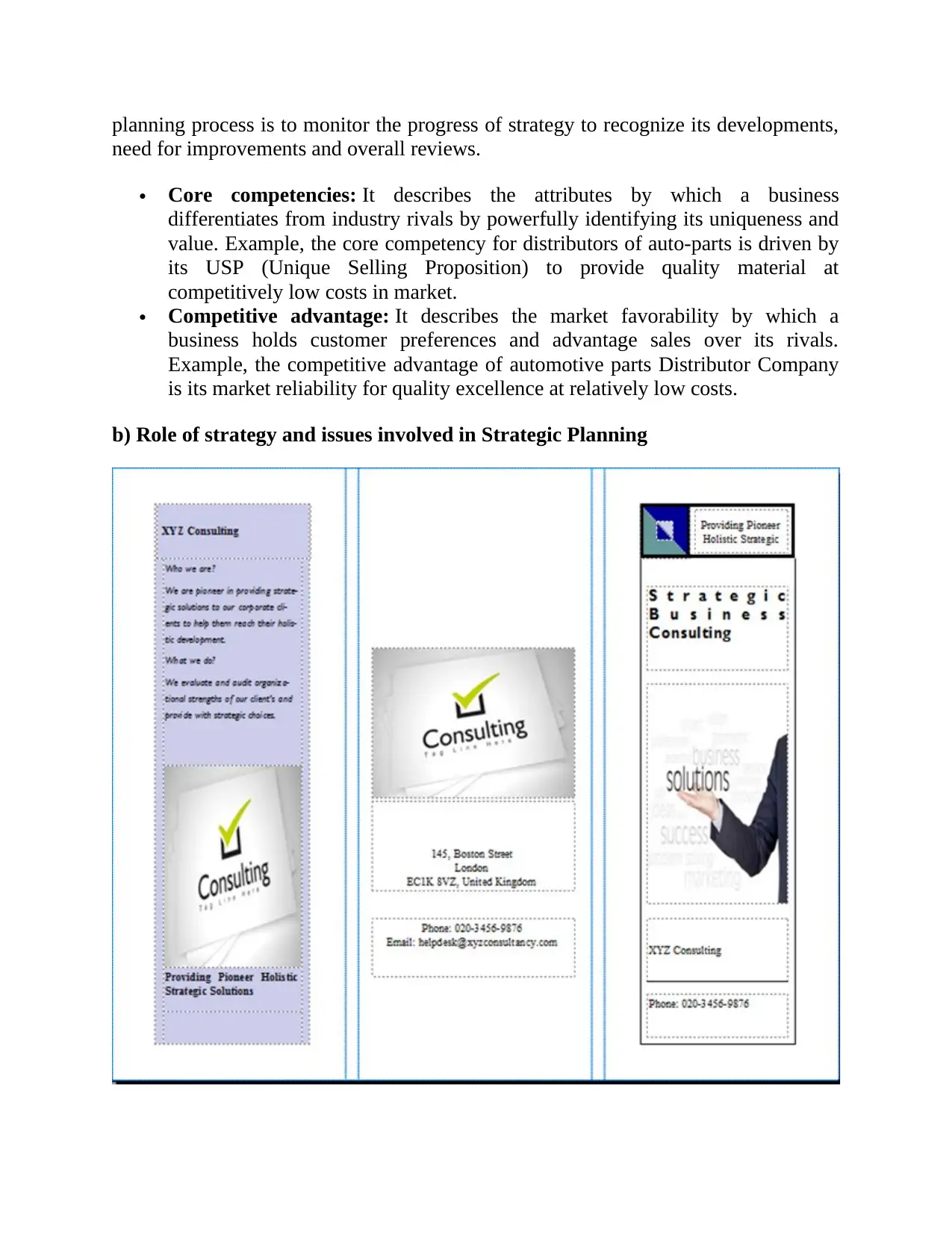
planning process is to monitor the progress of strategy to recognize its developments,
need for improvements and overall reviews.
Core competencies: It describes the attributes by which a business
differentiates from industry rivals by powerfully identifying its uniqueness and
value. Example, the core competency for distributors of auto-parts is driven by
its USP (Unique Selling Proposition) to provide quality material at
competitively low costs in market.
Competitive advantage: It describes the market favorability by which a
business holds customer preferences and advantage sales over its rivals.
Example, the competitive advantage of automotive parts Distributor Company
is its market reliability for quality excellence at relatively low costs.
b) Role of strategy and issues involved in Strategic Planning
need for improvements and overall reviews.
Core competencies: It describes the attributes by which a business
differentiates from industry rivals by powerfully identifying its uniqueness and
value. Example, the core competency for distributors of auto-parts is driven by
its USP (Unique Selling Proposition) to provide quality material at
competitively low costs in market.
Competitive advantage: It describes the market favorability by which a
business holds customer preferences and advantage sales over its rivals.
Example, the competitive advantage of automotive parts Distributor Company
is its market reliability for quality excellence at relatively low costs.
b) Role of strategy and issues involved in Strategic Planning
⊘ This is a preview!⊘
Do you want full access?
Subscribe today to unlock all pages.

Trusted by 1+ million students worldwide

The strategic planning is the description of the business road map and it talks
about competitive and strategic approaches that are undertaken to meet the interest of
their entire stakeholder’s and achieve the business objectives successfully. It specifies
the business mission, vision and plan to fulfill those (Objectives). In this process how,
when, what is decided for resource allocation and implementation. This process helps
a business to perform efficiently. (Simerson, 2011)
As strategy is basically a business directional plan so its role is to provide focus or
define its approach in a competitive way. It clarifies activities to meet objectives by
diagnosing the business strengths or characteristics with changes in environment so
that efficient planning can be designed to respond. This helps to make able decisions
about competitive and strategic approaches that are undertaken to meet the interest of
their entire stakeholder’s and achieve the business objectives successfully. It specifies
the business mission, vision and plan to fulfill those (Objectives). In this process how,
when, what is decided for resource allocation and implementation. This process helps
a business to perform efficiently. (Simerson, 2011)
As strategy is basically a business directional plan so its role is to provide focus or
define its approach in a competitive way. It clarifies activities to meet objectives by
diagnosing the business strengths or characteristics with changes in environment so
that efficient planning can be designed to respond. This helps to make able decisions
Paraphrase This Document
Need a fresh take? Get an instant paraphrase of this document with our AI Paraphraser

for successful outcomes with available resources. Overall strategy helps to analyze
and monitor business for its growth. According to Mintzberg, strategy has 5 P’s:
Perspective: which describes the thinking and attitude of the business and its
people. This pattern moulds the behavior, response and aptitude depending on
culture of an organization. Example, for the auto-part distribution company
discussed above, the focus is on excellence in quality at low cost, so their
strategy should talk about how their services are built on this aspect.
Plan: which describes how objectives are to be achiev ed step-by-step.
Example, for auto-parts distributor the strategy should focus on optimum use of
resources to cut costs effectively.
Pattern: which describes the conscious or consistent approach of business.
Example, for this distributor, decision is based on cost strategic advantages that
are designed after consistent market research to optimize entire resources.
Position:which describes how a business responds to align the organizational
needs with environment needs. Example, for this distributor, strategy is
positioned on low price differentiation with good quality as advantage over
rivals.
Ploy which describes witty advantage over competitors. Example, for this distributor,
the strategy plotting can be low priced bulk sales. This will increase sales volume
keeping the costs marginally low compared to rivals. (Prahalad & Hamel, 2010)
Though useful but strategy can also be countered with problems such as lack of
clarified purpose, communication, information, approach, competence, resources etc.
There can also be other issues such as problems within leadership, organizational
culture, unrealistic expectations and unplanned changes faced from customer,
environment or employees.
Planning Techniques
BCG matrix is planning for potential of product or business portfolio for investments
and markets. They define existing competence and future probability creation. This
helps to decide on investments, developments or decline of products. It decides on
growth and market share dimensions based on aspects of stars, cows, dogs and
questions mark. (Griffin, 2007). This is illustrated in the figure below.
and monitor business for its growth. According to Mintzberg, strategy has 5 P’s:
Perspective: which describes the thinking and attitude of the business and its
people. This pattern moulds the behavior, response and aptitude depending on
culture of an organization. Example, for the auto-part distribution company
discussed above, the focus is on excellence in quality at low cost, so their
strategy should talk about how their services are built on this aspect.
Plan: which describes how objectives are to be achiev ed step-by-step.
Example, for auto-parts distributor the strategy should focus on optimum use of
resources to cut costs effectively.
Pattern: which describes the conscious or consistent approach of business.
Example, for this distributor, decision is based on cost strategic advantages that
are designed after consistent market research to optimize entire resources.
Position:which describes how a business responds to align the organizational
needs with environment needs. Example, for this distributor, strategy is
positioned on low price differentiation with good quality as advantage over
rivals.
Ploy which describes witty advantage over competitors. Example, for this distributor,
the strategy plotting can be low priced bulk sales. This will increase sales volume
keeping the costs marginally low compared to rivals. (Prahalad & Hamel, 2010)
Though useful but strategy can also be countered with problems such as lack of
clarified purpose, communication, information, approach, competence, resources etc.
There can also be other issues such as problems within leadership, organizational
culture, unrealistic expectations and unplanned changes faced from customer,
environment or employees.
Planning Techniques
BCG matrix is planning for potential of product or business portfolio for investments
and markets. They define existing competence and future probability creation. This
helps to decide on investments, developments or decline of products. It decides on
growth and market share dimensions based on aspects of stars, cows, dogs and
questions mark. (Griffin, 2007). This is illustrated in the figure below.
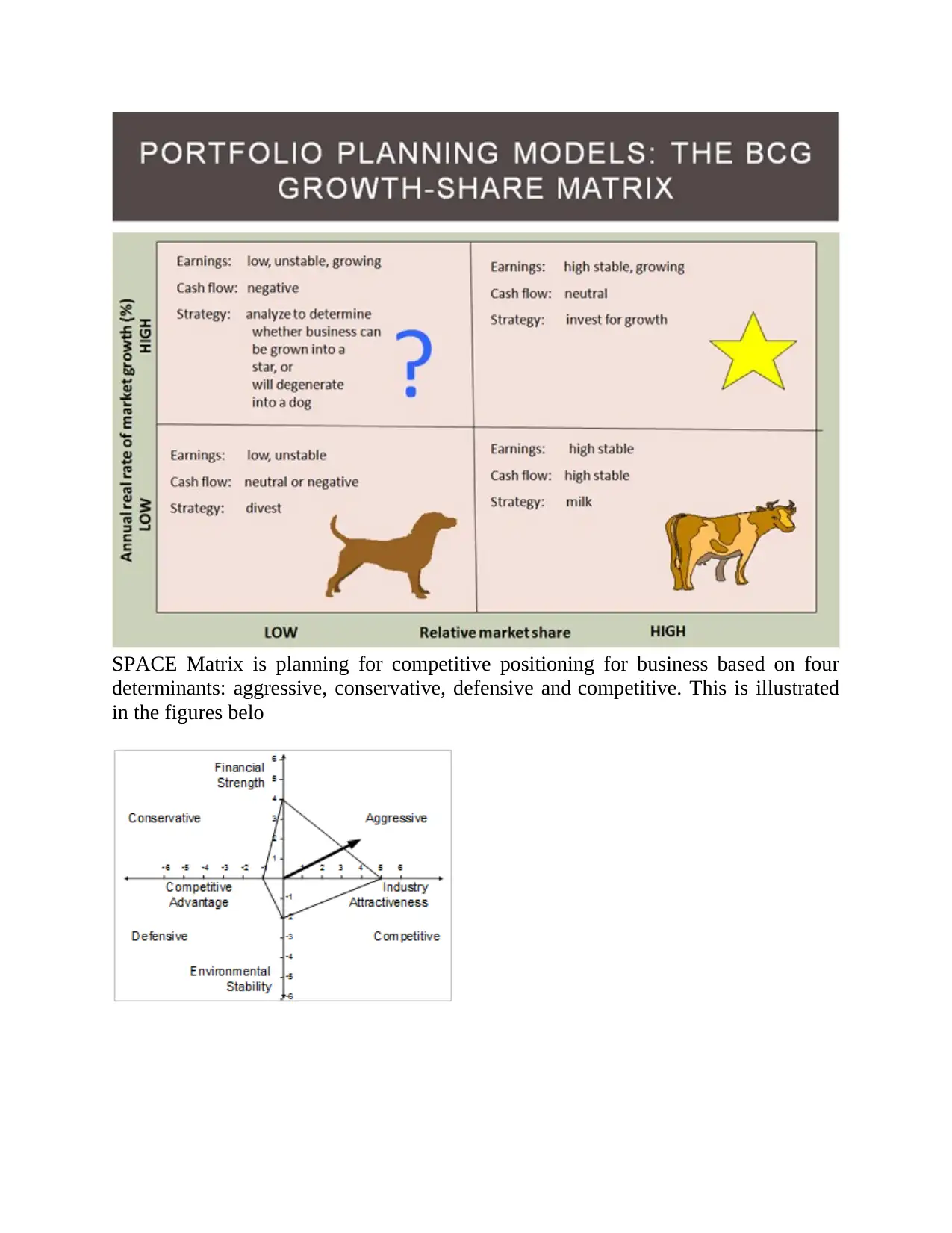
SPACE Matrix is planning for competitive positioning for business based on four
determinants: aggressive, conservative, defensive and competitive. This is illustrated
in the figures belo
determinants: aggressive, conservative, defensive and competitive. This is illustrated
in the figures belo
⊘ This is a preview!⊘
Do you want full access?
Subscribe today to unlock all pages.

Trusted by 1+ million students worldwide
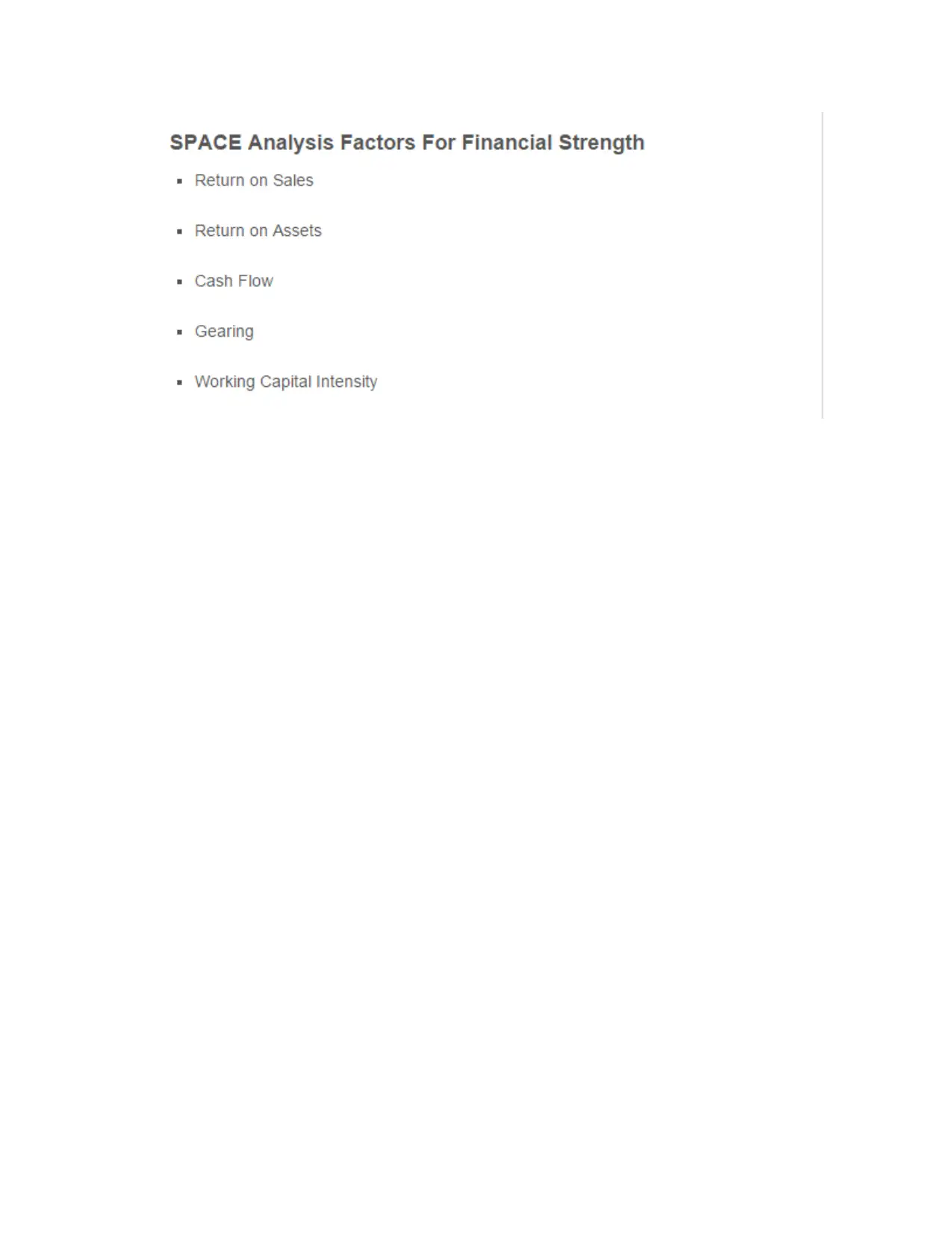
Paraphrase This Document
Need a fresh take? Get an instant paraphrase of this document with our AI Paraphraser
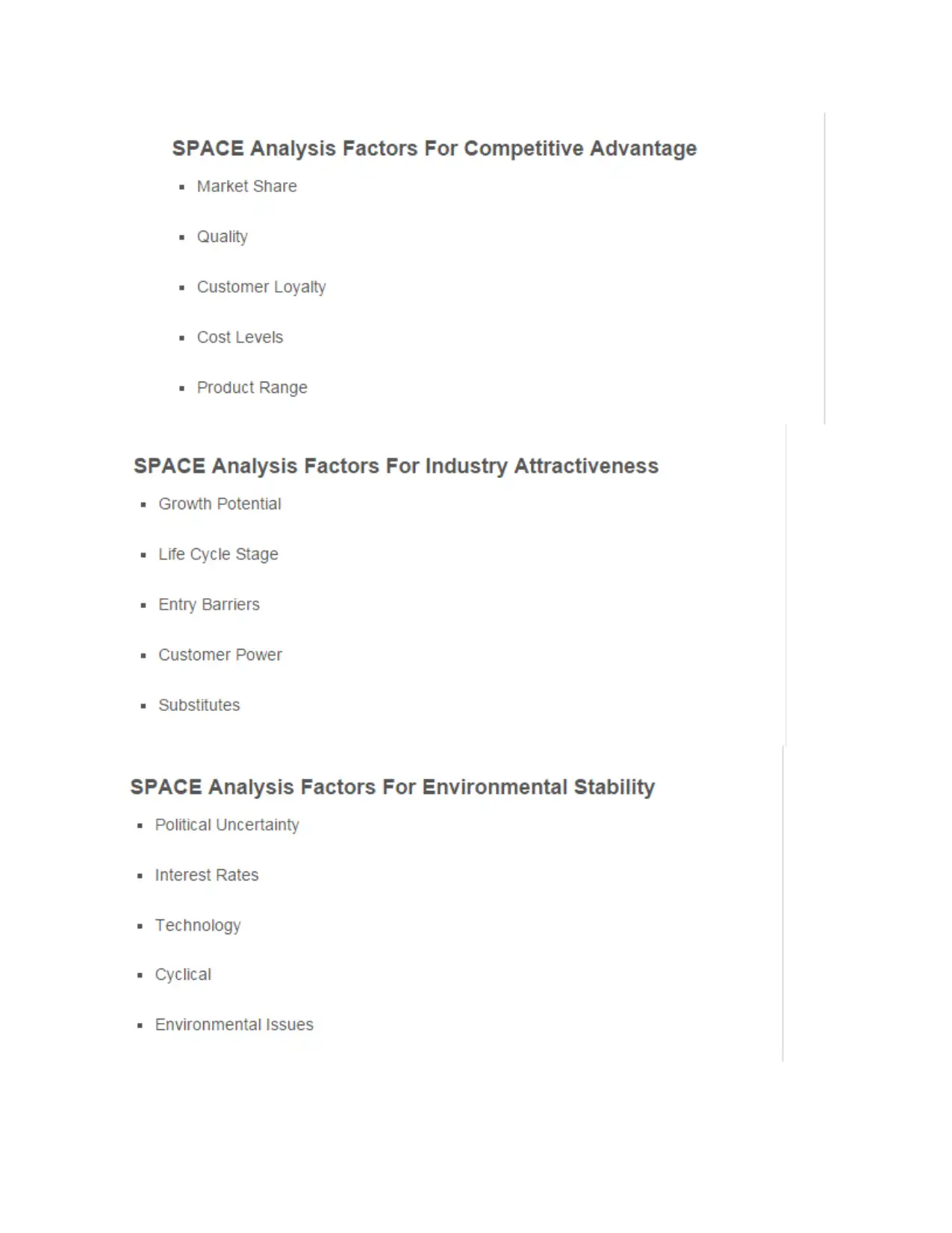

c) Discuss in details, the utility and application of either the BCG matrix
(Boston Consulting Group) as a growth planning technique OR the SPACE
matrix as a strategic positioning technique for managers
BCG Matrix as growth planning technique:
This matrix evaluates the positioning of product in response to environmental
challenges to help decide business strategies for growth and market share. It helps to
identify current strength and future potentials. This is determined by:
Stars: where products have strong growth and market share. To sustain this
dominance and future development they need to keep investments flowing.
Examples, for Amazon star products are e-movies, kindle
Cash cows: where products sustain high market share but have low scope for
further growth. These are money maker products but face low competition.
Examples, Amazon e-books hold market dominance but low growth.
Dogs:where products have low market share and weak growth. These should be
divested as they show poor returns on inputs such as investments, resources,
time and efforts. Example, in Amazon there are no products which are in this
quadrant.
Question mark: where products show high growth prospects but capture low
market shares. So, they need proper promotion or penetration in market to
balance income compared to high investments done on them. Example, certain
software and on demand video’s of Amazon fall in this quadrant. (Krumova,
2013)
(Boston Consulting Group) as a growth planning technique OR the SPACE
matrix as a strategic positioning technique for managers
BCG Matrix as growth planning technique:
This matrix evaluates the positioning of product in response to environmental
challenges to help decide business strategies for growth and market share. It helps to
identify current strength and future potentials. This is determined by:
Stars: where products have strong growth and market share. To sustain this
dominance and future development they need to keep investments flowing.
Examples, for Amazon star products are e-movies, kindle
Cash cows: where products sustain high market share but have low scope for
further growth. These are money maker products but face low competition.
Examples, Amazon e-books hold market dominance but low growth.
Dogs:where products have low market share and weak growth. These should be
divested as they show poor returns on inputs such as investments, resources,
time and efforts. Example, in Amazon there are no products which are in this
quadrant.
Question mark: where products show high growth prospects but capture low
market shares. So, they need proper promotion or penetration in market to
balance income compared to high investments done on them. Example, certain
software and on demand video’s of Amazon fall in this quadrant. (Krumova,
2013)
⊘ This is a preview!⊘
Do you want full access?
Subscribe today to unlock all pages.

Trusted by 1+ million students worldwide
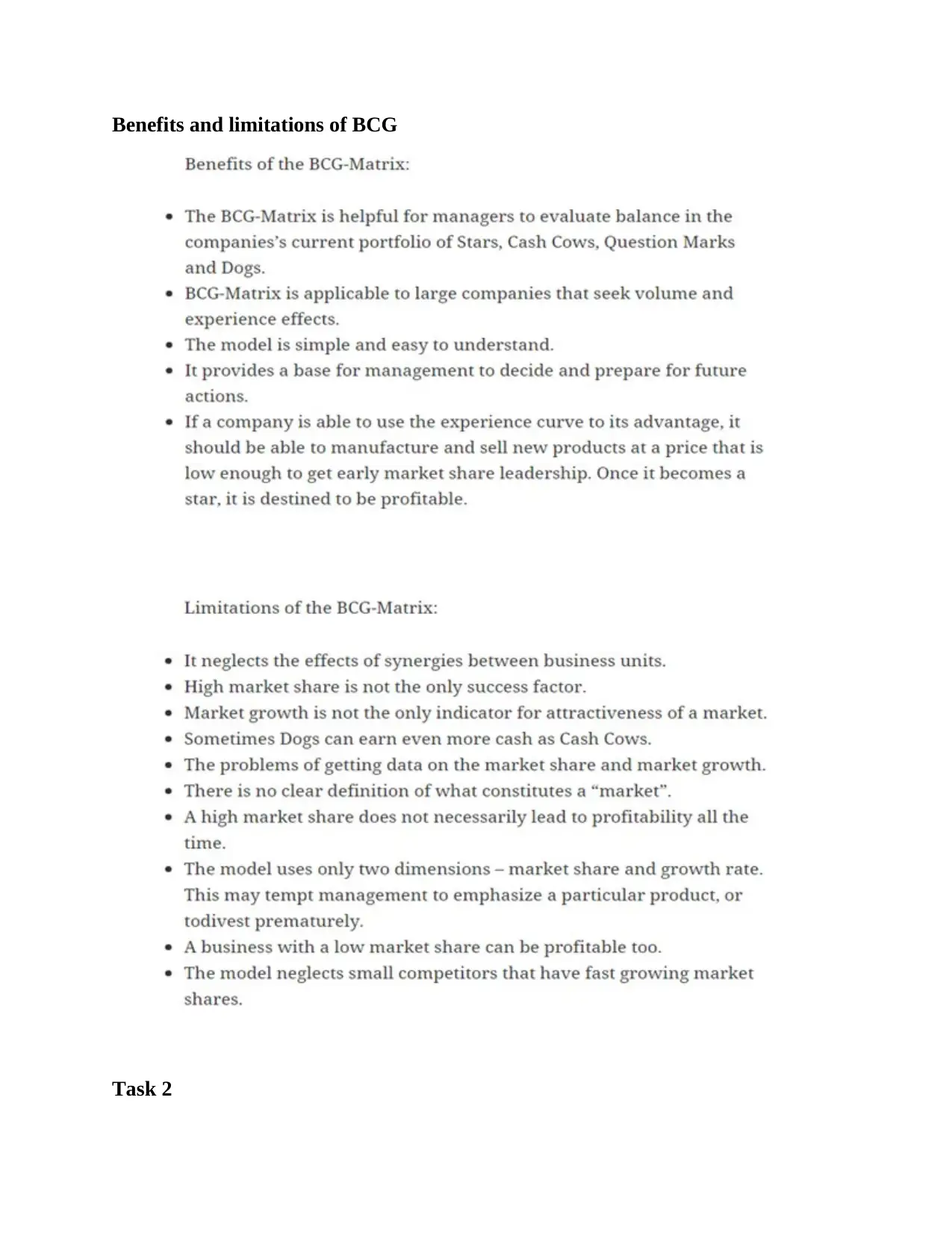
Benefits and limitations of BCG
Task 2
Task 2
Paraphrase This Document
Need a fresh take? Get an instant paraphrase of this document with our AI Paraphraser

a)Explain to the interns how the ANSOFF Matrix OR the SWOT Analysis has
helped you to carry out an organizational audit for one of your client companies
To carry out the organizational audit SWOT is a useful analytical tool as it evaluates
the internal and external competence and resources with the micro and macro
environments of the business. This tool helps a business understand their own
capacity and competitive advantage, evaluate competitor’s situation, recognize own
opportunities and strategic response. (Bohm, 2009)
As per the case scenario, I have been working as strategy consultant where I used to
carry out organizational audits for my client companies. The use of SWOT tool has
helped me carry out my analysis. Example, I would like to discuss SWOT analysis for
Mulberry and how it has improved their functioning.
Strengths Weakness
Mulberry is a renowned name in
fashion industry for exclusive
design and product quality.
Enriched British culture is a strong
element of their products and they
have global reach with outlets
located in Asia, Europe, US and
Australia.
Strong customer base, reliance and
demand for Mulberry’s product due
to their quality.
Strong and skilled craftsmen who
design for innovation and creativity.
High built technology in production
process, well equipped facilities and
training of employees helps to
sustain their market leadership.
Mulberry has probably
encountered few weaknesses due
to their inheritance of strong
working culture, values and proper
planning for strategic objectives
and functions.
As Mulberry is engaged with
various trade partners in off-shore
networks hence, minor weakness
occur based on environment,
security and punctuality which
gets improved as per
circumstances.
Opportunities Threats
As Mulberry is a big fashion house
with worthy income, hence scope
stands for increased expansion both
Mulberry encounters low threats
from substitute fashion products
and new entrants as both would
helped you to carry out an organizational audit for one of your client companies
To carry out the organizational audit SWOT is a useful analytical tool as it evaluates
the internal and external competence and resources with the micro and macro
environments of the business. This tool helps a business understand their own
capacity and competitive advantage, evaluate competitor’s situation, recognize own
opportunities and strategic response. (Bohm, 2009)
As per the case scenario, I have been working as strategy consultant where I used to
carry out organizational audits for my client companies. The use of SWOT tool has
helped me carry out my analysis. Example, I would like to discuss SWOT analysis for
Mulberry and how it has improved their functioning.
Strengths Weakness
Mulberry is a renowned name in
fashion industry for exclusive
design and product quality.
Enriched British culture is a strong
element of their products and they
have global reach with outlets
located in Asia, Europe, US and
Australia.
Strong customer base, reliance and
demand for Mulberry’s product due
to their quality.
Strong and skilled craftsmen who
design for innovation and creativity.
High built technology in production
process, well equipped facilities and
training of employees helps to
sustain their market leadership.
Mulberry has probably
encountered few weaknesses due
to their inheritance of strong
working culture, values and proper
planning for strategic objectives
and functions.
As Mulberry is engaged with
various trade partners in off-shore
networks hence, minor weakness
occur based on environment,
security and punctuality which
gets improved as per
circumstances.
Opportunities Threats
As Mulberry is a big fashion house
with worthy income, hence scope
stands for increased expansion both
Mulberry encounters low threats
from substitute fashion products
and new entrants as both would

in domestic and offshore markets.
Rapid growth and development in
transport and delivery networks with
more real-time communication
facilities provides opportunities for
more ultra-level effectiveness in its
service quality.
require huge investments to match
their individuality.
However, decline in the number
of skilled craftsmen is a threat to
sustain heritage fashion, keeping in
balance with increasing demand
for Mulberry products.
b) Discuss with the interns, how your firm would carry out an environmental
audit for one of your clients by either utilizing the PORTER Five Forces OR the
PESTEL framework
Porter’s 5 Forces model is an analytical tool by which a counter strategy can be
planned against competitive forces. This helps to evaluate and hence formulate the
position of the business and its economic intensity in a manner that is difficult to be
attacked.
Example, the environment audit for Mulberry will help to understand PORTER’S 5
FORCES:
Threat of Substitutes: Mulberry practically faces no sustained threat of
substitutes as their products bear significant quality which is hard to imitate.
Also, their production process and operational functions are technically so well
built that their products can’t be substituted in terms of quality and hence they
own their individuality. Moreover, as the customers for their products are
highly exclusive by nature, so their switching to substitute products is minimal.
Bargaining power of Buyers: Mulberry faces high bargaining power of their
buyers or customer’s who prefer value bargaining and not cost switching.
These powerful and affluent mass of buyers are faithful to designer than to
retailer. Hence, Mulberry is bound to maintain its value chain.
Bargaining power of Suppliers: Mulberry is a great fashion house which
maintains its legacy of craftsmanship. Also, as there is significant decline of
skilled craftsmen, hence, bargaining power from suppliers is low. Even,
Mulberry significantly values its suppliers and believes in retaining
relationships with them to continue their legacy with quality and creativity.
Hence, both Mulberry and their suppliers have win-win situation.
Competitive rivalry: Mulberry is a great name in luxury fashion which has
established its own individuality among customers. Also, it faces low switching
Rapid growth and development in
transport and delivery networks with
more real-time communication
facilities provides opportunities for
more ultra-level effectiveness in its
service quality.
require huge investments to match
their individuality.
However, decline in the number
of skilled craftsmen is a threat to
sustain heritage fashion, keeping in
balance with increasing demand
for Mulberry products.
b) Discuss with the interns, how your firm would carry out an environmental
audit for one of your clients by either utilizing the PORTER Five Forces OR the
PESTEL framework
Porter’s 5 Forces model is an analytical tool by which a counter strategy can be
planned against competitive forces. This helps to evaluate and hence formulate the
position of the business and its economic intensity in a manner that is difficult to be
attacked.
Example, the environment audit for Mulberry will help to understand PORTER’S 5
FORCES:
Threat of Substitutes: Mulberry practically faces no sustained threat of
substitutes as their products bear significant quality which is hard to imitate.
Also, their production process and operational functions are technically so well
built that their products can’t be substituted in terms of quality and hence they
own their individuality. Moreover, as the customers for their products are
highly exclusive by nature, so their switching to substitute products is minimal.
Bargaining power of Buyers: Mulberry faces high bargaining power of their
buyers or customer’s who prefer value bargaining and not cost switching.
These powerful and affluent mass of buyers are faithful to designer than to
retailer. Hence, Mulberry is bound to maintain its value chain.
Bargaining power of Suppliers: Mulberry is a great fashion house which
maintains its legacy of craftsmanship. Also, as there is significant decline of
skilled craftsmen, hence, bargaining power from suppliers is low. Even,
Mulberry significantly values its suppliers and believes in retaining
relationships with them to continue their legacy with quality and creativity.
Hence, both Mulberry and their suppliers have win-win situation.
Competitive rivalry: Mulberry is a great name in luxury fashion which has
established its own individuality among customers. Also, it faces low switching
⊘ This is a preview!⊘
Do you want full access?
Subscribe today to unlock all pages.

Trusted by 1+ million students worldwide
1 out of 18
Related Documents
Your All-in-One AI-Powered Toolkit for Academic Success.
+13062052269
info@desklib.com
Available 24*7 on WhatsApp / Email
![[object Object]](/_next/static/media/star-bottom.7253800d.svg)
Unlock your academic potential
Copyright © 2020–2025 A2Z Services. All Rights Reserved. Developed and managed by ZUCOL.




